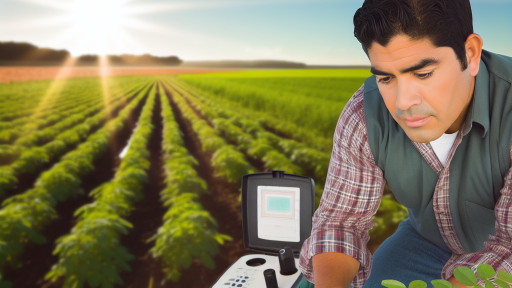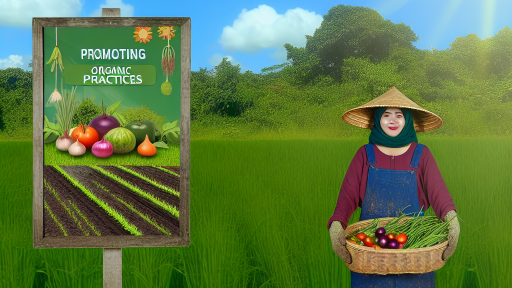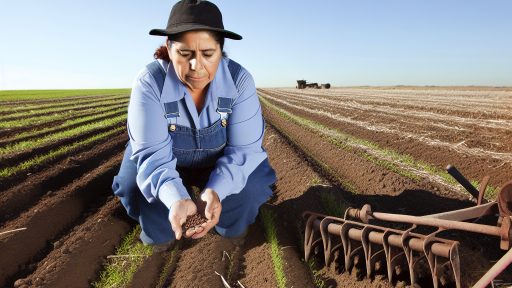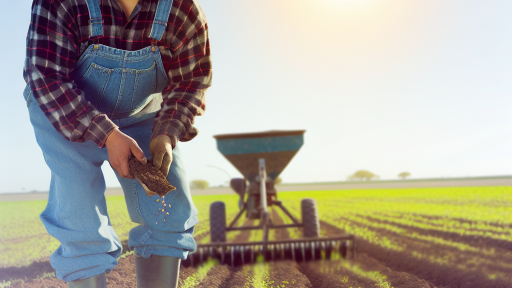Introduction to Organic Farming and Precision Agriculture
Organic farming focuses on sustainability and environmentally friendly practices.
It avoids synthetic fertilizers and pesticides, promoting natural processes instead.
This method enhances soil health, biodiversity, and ecosystem balance.
On the other hand, precision agriculture leverages technology for optimized farming.
It uses data analysis and monitoring tools to enhance crop yield.
Farmers can practice precise planting, watering, and fertilization methods.
These methods lead to more efficient resource utilization.
Combining organic farming with precision agriculture creates a powerful synergy.
This integration maximizes yield while maintaining ecological integrity.
Benefits of Organic Farming
Organic farming enhances soil health through natural amendments.
It increases biodiversity within the farming ecosystem.
Moreover, it reduces the risk of chemical contamination in food products.
Consumers often prefer organic products for their perceived health benefits.
Additionally, organic practices can lead to better water management.
Precision Agriculture Technologies
Various technologies enhance precision agriculture practices.
Transform Your Agribusiness
Unlock your farm's potential with expert advice tailored to your needs. Get actionable steps that drive real results.
Get StartedGPS-guided equipment allows for accurate field mapping.
Drones provide aerial imagery for assessing crop conditions.
Soil sensors monitor moisture levels and nutrient availability.
Data analytics tools help farmers make informed decisions.
Combining Both Approaches for Better Outcomes
The integration of both organic and precision farming enhances productivity.
Farmers can apply organic fertilizers precisely based on soil needs.
Moreover, monitoring crop health leads to timely interventions.
This combination minimizes environmental impact while ensuring profitability.
Ultimately, it fosters a sustainable agricultural future.
Benefits of Combining Organic Farming with Precision Techniques
Enhanced Resource Management
Organic farming benefits greatly from precision agriculture techniques.
This combination optimizes the use of water and nutrients.
Farmers can precisely monitor soil health and moisture levels.
As a result, crops receive the exact nutrients they need.
Furthermore, this approach reduces waste and minimizes runoff.
Increased Crop Yields
Precision agriculture allows farmers to boost their crop yields significantly.
Targeted interventions lead to healthier plants and optimized growth conditions.
Through data analysis, farmers can identify critical growth factors.
Consequently, they can adjust practices based on real-time information.
This adaptability enhances overall productivity in organic farming.
Improved Pest and Disease Management
Combining organic practices with precision techniques strengthens pest control.
Farmers can pinpoint pest infestations early through monitoring tools.
Thus, they can apply targeted organic solutions effectively.
This minimizes pesticide use and supports ecological health.
Ultimately, it leads to healthier crops and increased yields.
Showcase Your Farming Business
Publish your professional farming services profile on our blog for a one-time fee of $200 and reach a dedicated audience of farmers and agribusiness owners.
Publish Your ProfileCost Efficiency
Integrating precision agriculture reduces costs for organic farmers.
By optimizing inputs, farmers can maximize their return on investment.
Data-driven decisions allow for smarter resource allocation.
This approach often results in lower operational costs.
Additionally, it reduces the need for expensive synthetic inputs.
Environmental Sustainability
The combination promotes sustainable farming practices.
Less chemical use protects surrounding ecosystems and water sources.
Precision techniques minimize environmental impact through efficient practices.
As a result, organic farmers contribute to biodiversity preservation.
This aligns with overall sustainability goals in agriculture.
Technological Tools for Precision Agriculture in Organic Farms
Introduction to Precision Agriculture
Precision agriculture enhances farming efficiency and sustainability.
It involves detailed data collection on crops and soil health.
This approach helps organic farmers make informed decisions.
GPS Technology
Global Positioning System (GPS) technology plays a crucial role.
Farmers use GPS to assess field variability accurately.
This technology allows for precise planting and harvesting.
Field Mapping
Creating detailed field maps enhances management decisions.
Farmers can identify areas needing attention.
Moreover, mapping improves resource allocation.
Sensors and IoT Devices
Sensors monitor a variety of soil and environmental conditions.
They provide valuable data on moisture and temperature levels.
This data enables timely farming interventions.
Soil and Crop Sensors
Soil sensors measure nutrient levels in real time.
This information helps farmers optimize fertilization strategies.
Crop sensors track growth stages, indicating necessary actions.
Drones and Aerial Imagery
Drones offer unique aerial perspectives for monitoring crops.
Aerial imagery helps identify pest infestations and diseases.
Farmers can address these issues before they escalate.
Mapping Crop Health
Drones can create health maps showing areas of concern.
This technology allows for targeted treatments, which saves inputs.
Consequently, it promotes better health for organic crops.
Data Management Software
Robust data management software supports decision-making processes.
Farmers can analyze and interpret collected data effectively.
This software often integrates with various agricultural technologies.
Analytics and Reporting
Analytics tools enhance data-driven strategies for farmers.
Reports generated can guide future farming practices.
This focus on analytics fosters continuous improvement in operations.
Integrating Technology for Sustainable Practices
Integrating these technologies promotes sustainable organic farming.
Farmers achieve better yields while preserving ecological health.
As technology advances, organic farming will continue to thrive.
Showcase Your Farming Business
Publish your professional farming services profile on our blog for a one-time fee of $200 and reach a dedicated audience of farmers and agribusiness owners.
Publish Your ProfileGain More Insights: Organic Crop Planning for Year-Round Success
Data Collection Methods for Soil Health and Crop Yield
Importance of Data Collection
Data collection is essential for precision agriculture.
It provides insights into soil health and crop yields.
Additionally, accurate data helps farmers make informed decisions.
Types of Data to Collect
Farmers should focus on several key data types.
Soi composition data reveals nutrient levels.
Moisture content data indicates irrigation needs.
Crop health data helps identify pest and disease issues.
Weather data can predict seasonal challenges.
Methods for Data Collection
Soil Sampling
Soil sampling remains a traditional yet effective method.
Farmers can collect samples from various field locations.
They should analyze these samples for nutrients and pH levels.
Remote Sensing Technologies
Remote sensing offers advanced data collection capabilities.
This technology uses satellites and drones to gather information.
Farmers can access real-time data on crop health.
Additionally, it identifies areas needing attention.
Sensors and IoT Devices
Sensors provide continuous monitoring of soil conditions.
Internet of Things (IoT) devices transmit data in real-time.
These technologies enhance decision-making through accurate data.
Data Management and Analysis
Collecting data is just the first step.
Farmers must also manage and analyze the data.
Data management software helps organize large datasets.
Analytics tools provide insights into patterns and trends.
Utilizing Data for Actionable Insights
Farmers can use collected data to make actionable decisions.
This approach optimizes resource usage and crop management.
Ultimately, it enhances soil health and boosts crop yields.
Discover More: Soil Health 101: Techniques to Boost Crop Growth Naturally
Utilizing Geographic Information Systems in Organic Farming
Introduction to GIS Technology
Geographic Information Systems (GIS) revolutionize organic farming practices.
This technology allows farmers to collect and analyze spatial data.
Moreover, GIS enhances decision-making through precise information.
Mapping Soil Variability
GIS enables farmers to map soil types across their land.
This mapping reveals the variability in soil nutrients and pH levels.
Consequently, farmers can tailor their crop management practices.
Additionally, they can apply organic amendments where needed.
Crop Monitoring and Health Assessment
Using GIS, farmers can track crop health over time.
The system integrates satellite imagery and field data.
This integration helps identify areas requiring attention.
Consequently, farmers can implement targeted interventions.
Efficient Irrigation Management
GIS helps optimize irrigation scheduling for organic farms.
Farmers can analyze rainfall patterns and soil moisture levels.
Showcase Your Farming Business
Publish your professional farming services profile on our blog for a one-time fee of $200 and reach a dedicated audience of farmers and agribusiness owners.
Publish Your ProfileAs a result, they apply water efficiently and conserve resources.
Furthermore, precision irrigation practices reduce runoff.
Integration with Other Technologies
GIS works effectively with GPS and remote sensing technologies.
This combination enhances data accuracy and task automation.
Farmers can monitor field conditions in real time.
Consequently, they can respond rapidly to changing conditions.
Case Studies of Successful Implementation
Several organic farms have successfully adopted GIS.
For instance, Green Hills Farm increased yield by analyzing soil data.
Similarly, Maple Leaf Organic Farms improved water management.
These case studies illustrate the practical benefits of GIS.
Challenges and Considerations
Implementing GIS can present various challenges for farmers.
Training staff on GIS technology requires time and resources.
Additionally, the initial setup costs can be significant.
Nonetheless, the long-term benefits often outweigh these challenges.
Delve into the Subject: Unlocking the Secrets of Crop Rotation for Year-Round Yield
Implementing Variable Rate Technology for Organic Inputs
Understanding Variable Rate Technology
Variable Rate Technology (VRT) tailors inputs to suit specific field conditions.
This technology maximizes crop yields while minimizing resource waste.
Farmers can apply fertilizers and other inputs more effectively with VRT.
Benefits of VRT in Organic Farming
VRT promotes more efficient use of organic inputs.
This efficiency enhances soil health and reduces nutrient runoff.
Moreover, it can lead to significant cost savings for farmers.
Farmers can achieve better yields by precisely monitoring conditions.
Integration with Precision Agriculture
Integrating VRT with precision agriculture improves overall farm management.
Farmers can utilize satellite imagery and soil sensors for informed decisions.
This integration allows for consistent monitoring of crop health.
Ultimately, it fosters sustainable practices within organic farming.
Steps to Implement VRT
First, conduct soil tests to understand nutrient needs across the field.
Next, gather data on crop health using precision technology tools.
After that, develop a plan outlining variable application rates.
Finally, apply inputs according to the VRT plan and monitor results.
Challenges to Consider
One challenge is the initial investment in technology and equipment.
Additionally, farmers must overcome a learning curve with new systems.
Data management can also pose issues without proper training.
Despite these challenges, the long-term benefits are substantial.
Successful Case Studies
Many farmers have successfully integrated VRT into their operations.
For instance, Green Meadow Farm improved yields by 20% using VRT.
Similarly, Sun Harvest Organic Farm reduced input costs significantly.
Their experiences highlight the potential of VRT in organic farming.
You Might Also Like: Maximizing Crop Health: Why Micronutrients Matter More Than Ever
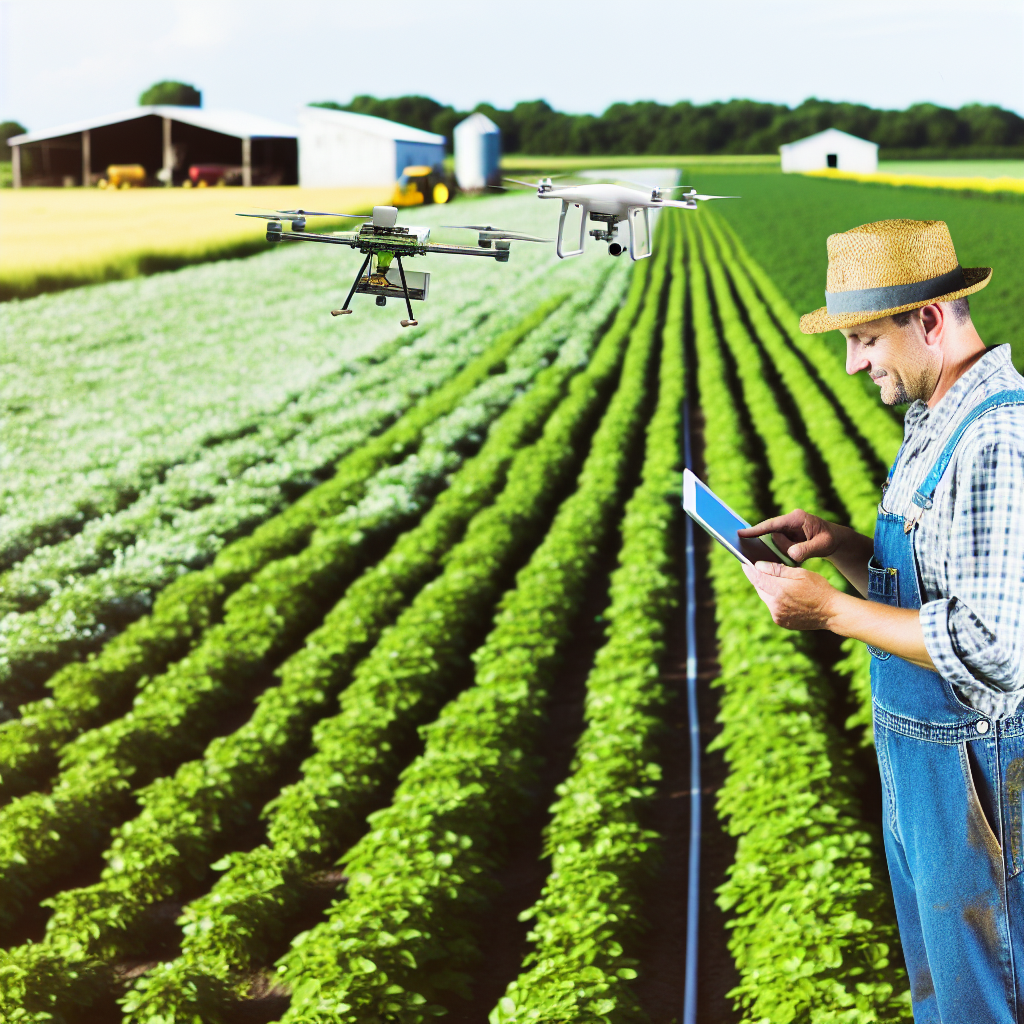
Monitoring Crop Health with Drones and Remote Sensing
The Role of Drones in Precision Agriculture
Drones have revolutionized crop monitoring on organic farms.
Showcase Your Farming Business
Publish your professional farming services profile on our blog for a one-time fee of $200 and reach a dedicated audience of farmers and agribusiness owners.
Publish Your ProfileThey provide real-time aerial imagery for better insights.
With advanced sensors, drones detect early signs of disease.
This capability allows farmers to take action promptly.
Moreover, drones help assess plant health across large areas.
Farmers can monitor crops without stepping onto the field.
Benefits of Using Remote Sensing Technology
Remote sensing offers a comprehensive view of crop conditions.
This method enhances decision-making in precision agriculture.
Sensors can measure moisture levels, temperature, and nutrient content.
Subsequently, farmers can optimize water and fertilizer usage.
Additionally, remote sensing captures data over time for analysis.
This history aids in predicting future crop performance.
Integrating Data for Effective Crop Management
Combining data from drones and sensors improves crop management.
Farmers can identify areas needing intervention quickly.
This targeted approach increases efficiency and reduces waste.
Data analysis helps in understanding crop growth patterns.
Consequently, farmers can adjust practices based on predictions.
Automation tools facilitate seamless data integration.
Challenges and Considerations
Despite benefits, challenges exist in adopting this technology.
High initial costs may deter some farm operations.
Additionally, interpreting data requires training and expertise.
Moreover, regulatory issues may affect drone usage.
Diverse field conditions can complicate sensor readings.
Future Trends in Crop Monitoring
The future of crop monitoring looks promising with innovation.
AI-powered drones may enhance data analysis capabilities.
Advancements in satellite imagery will complement drone use.
Farmers will benefit from more accurate predictions over time.
As technology progresses, costs are likely to decrease.
This accessibility will encourage widespread adoption among farmers.
Case Studies: Successful Organic Farms Using Precision Agriculture
Green Valley Farms
Green Valley Farms, located in Oregon, embraces precision agriculture techniques.
This farm specializes in organic berries and utilizes soil sensors effectively.
The sensors help monitor moisture levels and nutrient availability.
As a result, Green Valley achieves higher yields while maintaining organic standards.
Additionally, they apply variable-rate irrigation based on real-time data.
This approach minimizes water usage and optimizes berry growth.
Sunny Acres Organic Farm
Sunny Acres Organic Farm in California adopts drone technology for crop monitoring.
Using drones, they can assess crop health without stepping on the fields.
This method saves time and reduces soil compaction risks.
Furthermore, aerial imaging identifies areas needing immediate attention.
Sunny Acres also uses precision planting techniques to maximize spacing efficiency.
This results in improved crop production and resource utilization.
Showcase Your Farming Business
Publish your professional farming services profile on our blog for a one-time fee of $200 and reach a dedicated audience of farmers and agribusiness owners.
Publish Your ProfileMeadow Green Organic Cooperative
Meadow Green Organic Cooperative employs data analytics to drive farming decisions.
This cooperative analyzes weather patterns and soil data from multiple farms.
The insights help them plan planting schedules effectively.
Moreover, they monitor pest populations using smart traps connected to an app.
This proactive approach minimizes pesticide usage while maintaining crop health.
Members report increased satisfaction with yields and lower input costs.
Harvest Moon Farm
Harvest Moon Farm in New York adopts a holistic approach using precision agriculture.
This farm focuses on rotational grazing and cover cropping strategies.
By integrating livestock and crops, they enhance soil fertility naturally.
The use of GPS technology helps manage grazing patterns effectively.
As a result, the farm increases biodiversity and soil health.
Farmers notice significant improvements in crop resilience against pests.
Willow Creek Organic Farm
Willow Creek Organic Farm successfully implements precision data collection methods.
They utilize weather stations placed throughout the farm to gather data.
This information informs irrigation and fertilization practices.
Consequently, they tailor their approaches to fit the specific needs of each crop.
Willow Creek sees improvements in yield consistency and overall product quality.
Farmers enjoy lower input costs due to targeted application strategies.
Challenges and Solutions in Managing Organic Farms with Precision Agriculture
Understanding Precision Agriculture
Precision agriculture involves using technology to optimize farming practices.
This approach enhances the efficiency of farm management.
Farms can gather detailed data about their fields.
Farmers can make informed decisions based on this data.
Challenges Facing Organic Farms
Organic farms face unique challenges in precision agriculture.
One major challenge is regulatory compliance.
Farmers must adhere to strict organic standards.
These regulations can complicate the adoption of new technologies.
Soil Health Management
Maintaining soil health is essential for organic farming.
Precision tools may not fully track soil nutrient levels.
This gap can hinder effective soil management strategies.
Cost of Implementation
The initial investment in technology can be high.
Many organic farmers may struggle with this cost.
Balancing budget restrictions with technology needs can be tricky.
Adopting Effective Solutions
Despite these challenges, solutions exist to aid organic farmers.
Utilizing cost-effective technologies can make a difference.
Farmers can start with smaller, more affordable tools.
Gradually incorporating technology can alleviate financial pressure.
Data Integration and Analysis
Integrating data management systems is vital.
Farmers can analyze data trends for better decision-making.
This integration can lead to improved crop yields.
Education and Training
Investing in education is crucial for farmers.
Showcase Your Farming Business
Publish your professional farming services profile on our blog for a one-time fee of $200 and reach a dedicated audience of farmers and agribusiness owners.
Publish Your ProfileTraining programs can teach farmers about new technologies.
Farmers also learn how to implement these tools effectively.
Collaboration and Support Networks
Collaboration among farmers can enhance learning opportunities.
Joining networks helps share resources and knowledge.
These communities offer support in technology adoption.
Finding Local Resources
Local agricultural extension services can provide assistance.
Organizations can help with education and outreach programs.
Farmers should utilize these local resources to their advantage.
Leveraging Research and Development
Engaging with research institutions can be beneficial.
Farmers can stay informed about advancements in technology.
Research partnerships can drive innovation on organic farms.
Future Trends in Organic Farming and Precision Agriculture Integration
Advancements in Technology
Technology continues to evolve rapidly in the agricultural sector.
Innovations like drones and sensors enhance data collection.
Farmers can now monitor crop health more accurately.
This shift allows for timely interventions, reducing crop loss.
Furthermore, automated systems streamline farming practices.
Enhanced Data Analytics
Data analytics is a game-changer for organic farms.
By analyzing soil and weather data, farmers can make informed decisions.
This leads to improved crop yields and resource efficiency.
Integrating precision agriculture helps optimize inputs.
Consequently, this allows for sustainable farming practices.
Increased Focus on Sustainability
Sustainability remains a priority in modern agriculture.
Consumers prefer organically grown produce over conventional options.
This demand drives farmers to adopt eco-friendly methods.
Moreover, precision agriculture aligns with sustainable practices.
Using fewer chemicals protects biodiversity and water resources.
Regenerative Agriculture Practices
Regenerative agriculture is gaining traction among organic farmers.
This approach replenishes the soil and ecosystems.
Combining it with precision tools maximizes benefits.
Farmers are focusing on soil health and crop rotation.
Such practices mitigate climate change impacts effectively.
Collaboration and Knowledge Sharing
Farmers increasingly collaborate on best practices.
They share knowledge about emerging technologies and techniques.
This communal effort fosters innovation in organic farming.
Networking events and workshops are becoming common.
Such initiatives bridge the gap between traditional and modern farming.
Policy and Regulatory Changes
Governments are recognizing the importance of organic farming.
As a result, supportive policies are emerging worldwide.
These changes encourage the adoption of precision agriculture.
Grants and subsidies may help offset technology costs.
Showcase Your Farming Business
Publish your professional farming services profile on our blog for a one-time fee of $200 and reach a dedicated audience of farmers and agribusiness owners.
Publish Your ProfileThis support boosts farmer participation in sustainable practices.
Additional Resources
Novel approaches and practices to sustainable agriculture …
Organic small grain production in the Upper Midwest and Northeast …

